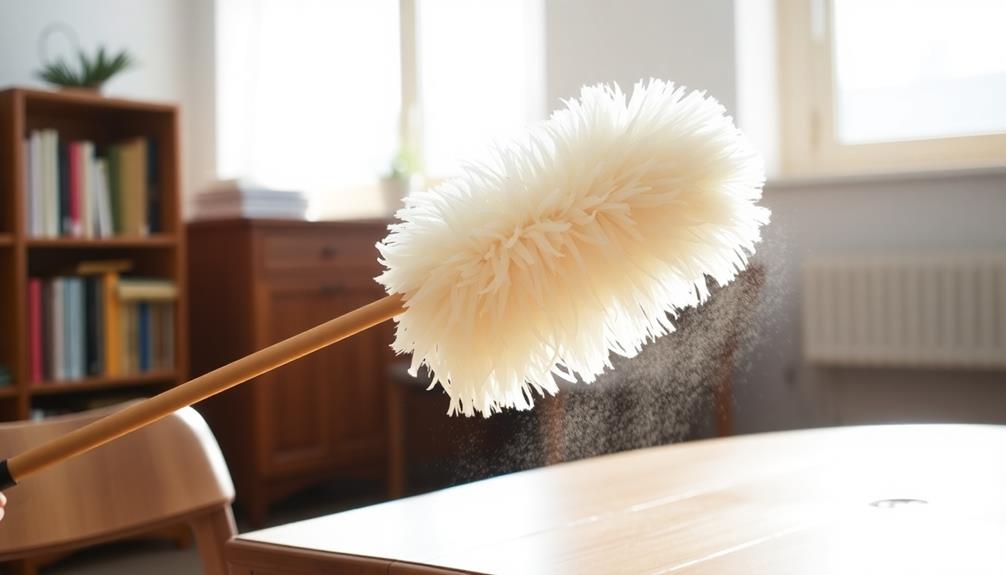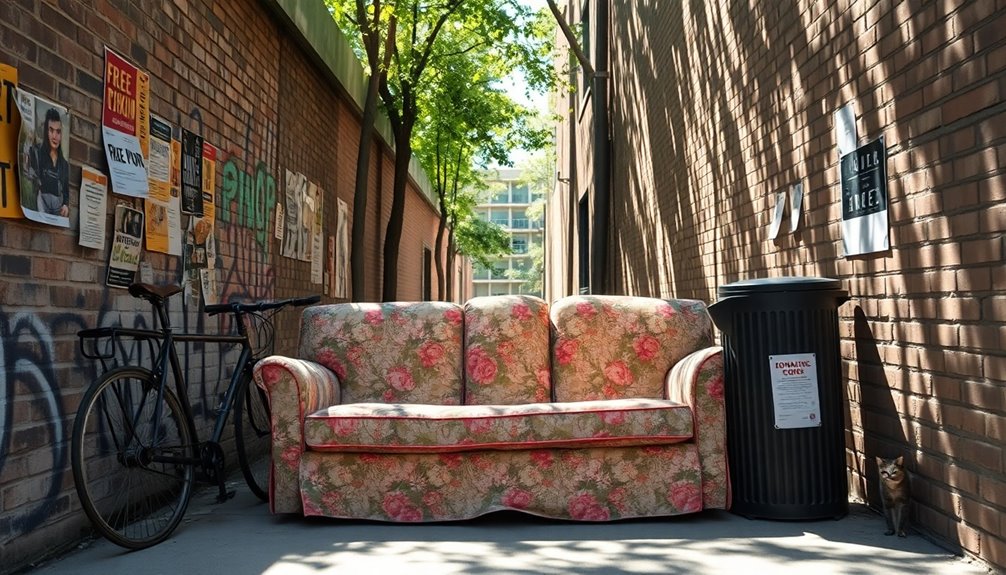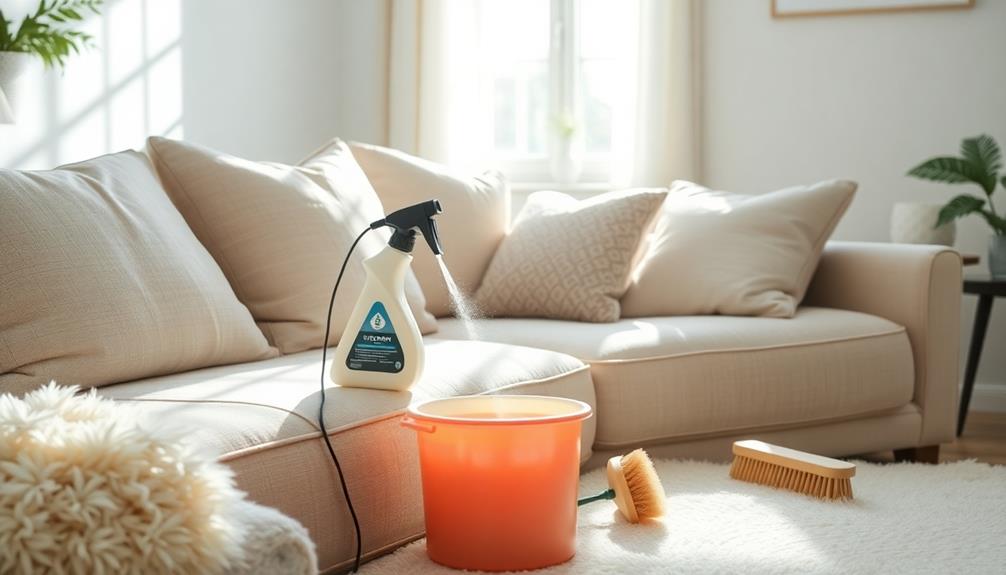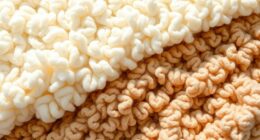In order to prevent dust from accumulating on your furniture, it is important to establish a regular cleaning routine. Using microfiber cloths, preferably slightly damp, can effectively trap dust. Always remember to dust from top to bottom for efficiency and consider incorporating dryer sheets on wooden surfaces to repel dust. Instead of sweeping, opt for vacuuming to minimize dust dispersal, and make sure to keep your air filters clean to reduce recirculation. Don’t overlook regularly vacuuming upholstered items and the surrounding areas to prevent dust buildup. By taking a proactive approach, you can significantly reduce dust accumulation. There are additional steps you can take to improve your dust management practices.
Key Takeaways
- Use microfiber cloths, slightly dampened, to effectively trap dust on furniture surfaces.
- Establish a regular cleaning routine and vacuum instead of sweeping to minimize dust dispersion.
- Limit pet access and brush them frequently to reduce dander accumulation on furniture.
- Incorporate dryer sheets on wooden surfaces to repel dust and reduce build-up.
- Maintain clean air filters and use air purifiers to improve overall air quality and reduce dust circulation.
Dusting Techniques for Furniture
When you’re ready to tackle dust on your furniture, employing effective dusting techniques can make all the difference. Start by using microfiber cloths, which are excellent for trapping dust particles. If you dampen them slightly, you’ll enhance their performance even more. Additionally, remember to dust from top to bottom, allowing the dust to fall to lower surfaces for easier cleanup. Using an upholstery attachment on your vacuum can also help to remove dust from fabric surfaces that cloths might miss. By following these simple strategies, you’ll learn how to effectively dust furniture and maintain a cleaner, healthier living space.
Additionally, maintaining good indoor air quality can help reduce dust accumulation on surfaces; consider using an air purifier maintenance guide for best results. Remember to dust your furniture surfaces from top to bottom. This technique prevents you from re-dusting lower areas, making your cleaning process more efficient.
For wooden surfaces, consider incorporating dryer sheets after dusting; they not only provide a cleaner look but also help repel future dust accumulation.
When it comes to upholstery, always check care tags for specific instructions. Using stiff brushes alongside baking soda can help lift embedded dust from your fabrics.
Don't forget about light fixtures and ceiling fans! They can gather dust and contribute to overall dust levels on your furniture surfaces. Regularly cleaning these areas guarantees that you minimize the dust settling back onto your furniture.
Preventing Dust Build-Up
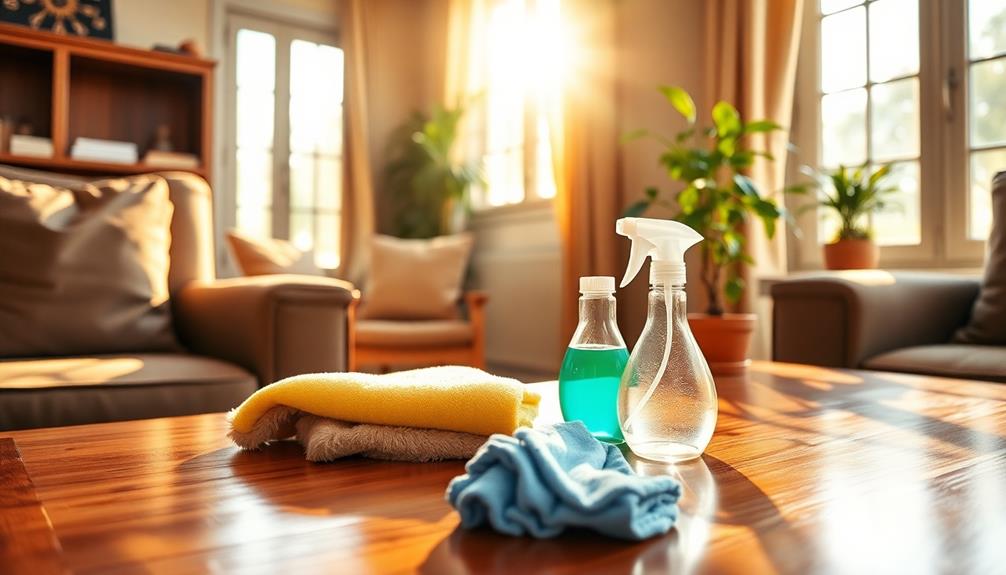
To effectively prevent dust build-up on your furniture, it's essential to establish a regular cleaning routine and adopt specific habits in your home.
Start by vacuuming your floors and surfaces regularly instead of sweeping, as this minimizes dust dispersion and reduces overall dust build-up. Consider using energy-efficient vacuum cleaners to help lower overall energy consumption while cleaning.
Limit pet access to your furniture, and make it a habit to brush your pets frequently. This reduces the accumulation of animal dander and hair, which can contribute to dust. By integrating smart home automation services into your cleaning routine, you can enhance your efficiency.
Be mindful of the products you use on your wood furniture; avoid oils, as they can attract more dust than untreated surfaces.
Additionally, keep your air filters clean and check your vents in heating or cooling systems. This practice prevents dust from being released back into the air and settling on your furniture.
Implementing doormats at entry points and adopting a no-shoes policy can greatly cut down on the outdoor dust brought into your home.
Maintenance of Upholstered Furniture
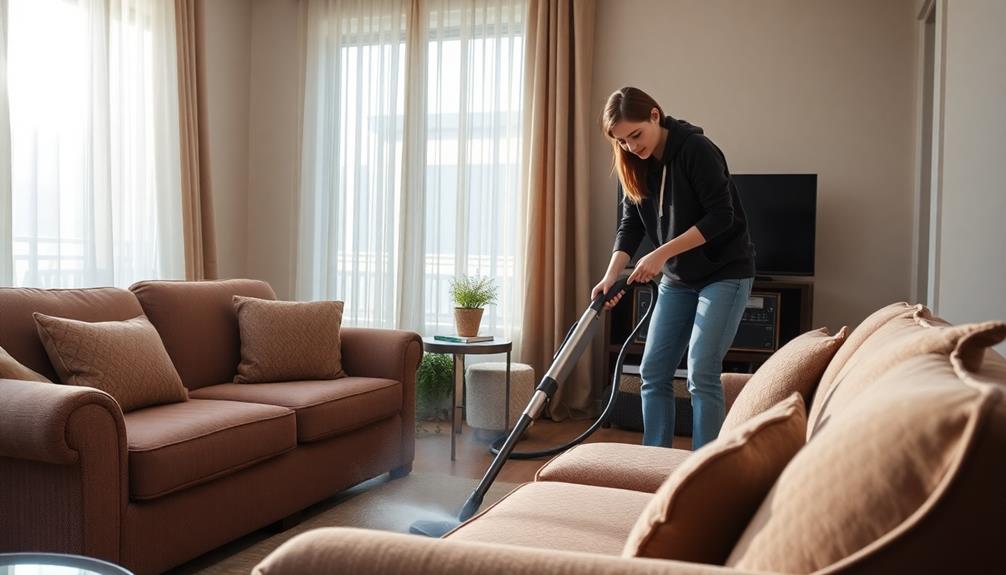
Maintaining upholstered furniture requires consistent effort and attention to detail to keep it looking fresh and dust-free. Regular vacuuming is essential; use appropriate attachments to capture dust and prevent it from settling into the upholstery.
Don't forget to vacuum nearby areas, as skin cells and hair from sheets and pillowcases contribute to dust accumulation on your furniture. Additionally, consider incorporating professional cleaning services for deep cleaning, which can help remove embedded dirt and allergens.
Consider using protective covers for your upholstered pieces. These can notably limit dust penetration and make cleaning easier, extending the lifespan of the fabric.
If you notice any stains, treat them immediately to prevent dirt and dust build-up, ensuring your upholstery remains clean and well-maintained.
Always follow the care tags on your furniture. They provide specific cleaning methods that can enhance dust management and maintain the integrity of the fabric.
DIY Dust Repellent Spray
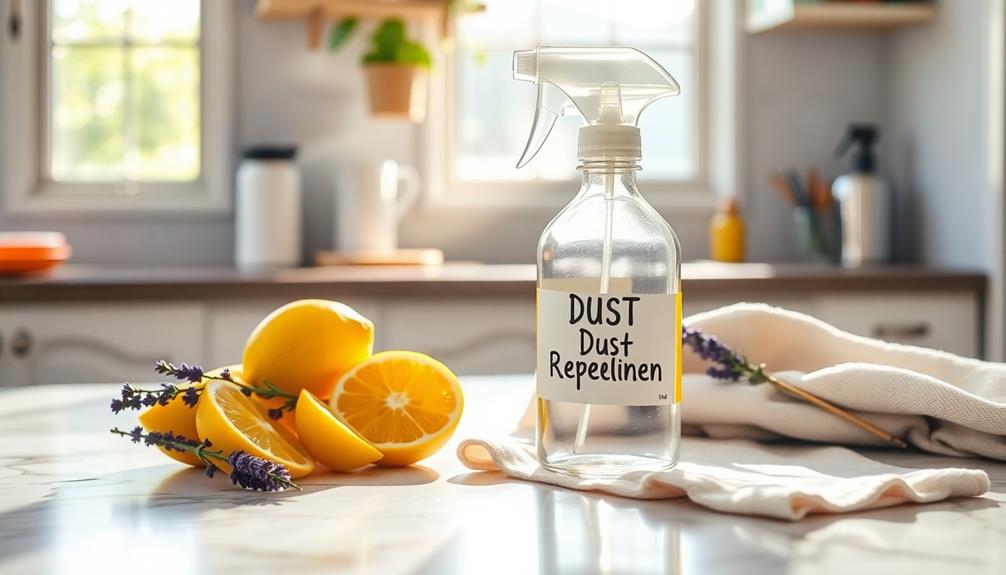
Keeping upholstered furniture clean isn't just about regular vacuuming and professional cleaning; using a DIY dust repellent spray can greatly enhance your dust management efforts.
This economical solution leverages common household ingredients to create a powerful cleaning tool that's easy to make. By combining basic items like vinegar, baking soda, and water, you can effortlessly tackle tough stains and grime throughout your home. However, it’s important to ensure proper ventilation when using the mixture, as breathing in vinegar fumes can be irritating to some individuals. With just a few affordable materials, this DIY cleaner is both cost-effective and environmentally friendly. Additionally, this natural cleaning solution avoids the use of harsh chemicals, making it a safer alternative for households with children or pets. However, while the ingredients are safe, it’s still essential to be mindful of vinegar fumes health risks, especially in enclosed spaces where fumes can accumulate. Always maintain good air circulation during and after cleaning to minimize any potential irritation.
Here's how to whip up your own dust repellent spray:
- Mix: Combine 2 cups of water with 1 cup of vinegar in a spray bottle. Vinegar disinfects surfaces and cuts through grime effectively.
- Add: Pour in 2 tablespoons of olive oil. This not only polishes surfaces but also creates a protective barrier that repels dust for longer.
- Enhance: Include 1-2 drops of dish soap to boost the cleaning power, breaking down grease and grime.
- Apply: Spray the mixture onto a microfiber cloth to avoid over-saturating your furniture.
This simple DIY dust repellent spray not only keeps your furniture looking fresh but also simplifies your cleaning routine.
With just a few steps, you can enjoy a dust-free home while using an effective and budget-friendly alternative to commercial products.
Additional Dust Management Strategies
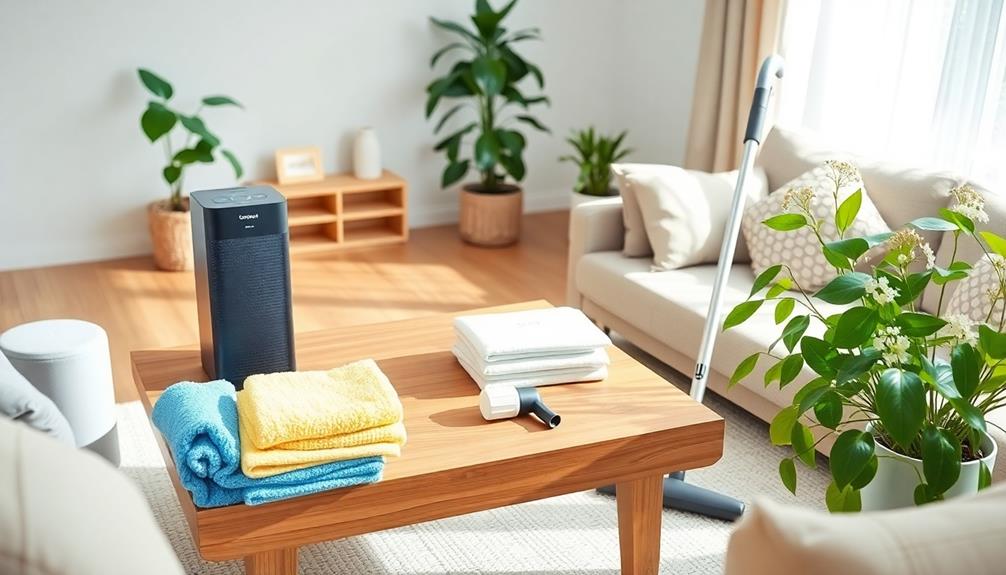
Dust management goes beyond just regular cleaning; it involves adopting a series of proactive strategies that can greatly reduce dust accumulation in your home.
Start by regularly cleaning light fixtures and ceiling fans. This prevents dust from settling on surfaces below, maintaining a cleaner environment.
Installing air purifiers equipped with HEPA filters can considerably enhance your indoor air quality. These devices capture up to 95% of airborne dust particles, helping to keep your space fresh.
Don't forget to schedule seasonal deep cleaning sessions—these are vital for tackling dust build-up in hard-to-reach areas that often get overlooked.
Maintaining ideal humidity levels is another essential strategy. Keeping humidity between 30% and 50% helps reduce the amount of dust that settles on surfaces.
Educate everyone in your household about minimizing dust contribution by implementing simple practices, like removing shoes at the door and managing clothing to decrease shedding.
Frequently Asked Questions
What Repels Dust From Furniture?
To repel dust from furniture, you can use a DIY dust-repellent spray, apply fabric softener sheets, regularly wax wood surfaces, utilize anti-static polishes, and install HEPA filter air purifiers for cleaner air.
How Do I Stop My Furniture From Attracting Dust?
To stop your furniture from attracting dust, avoid using oils, keep your environment tidy, and vacuum regularly using a brush attachment. Air purifiers with HEPA filters can also help reduce airborne dust considerably.
How to Make Your Furniture Dust Free?
To make your furniture dust-free, regularly apply a DIY dust-repellent spray, use microfiber cloths for cleaning, enforce a no-shoes policy, and maintain air filters to capture airborne particles. Wax wooden surfaces for added protection.
What Is the Best Way to Protect Furniture From Dust?
You think dust's just a harmless sprinkle? Think again! To protect your furniture, you can use air purifiers, apply dust-repellent sprays, and embrace microfiber cloths. You'll be amazed at how much easier life gets!
Conclusion
To keep your furniture looking fresh, remember that a single household can accumulate up to 40 pounds of dust each year! By incorporating regular dusting techniques and preventive measures, you can greatly reduce this buildup. Don't forget to maintain your upholstered pieces and try out a DIY dust repellent spray for an extra layer of protection. With these strategies in place, you'll enjoy a cleaner, healthier home and a more inviting space for you and your guests.
